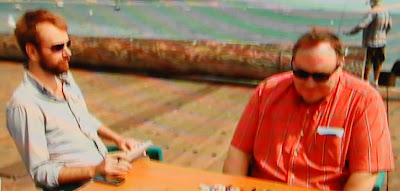CREATIVITY
We have long admired great thinkers or other creative people. What makes Picasso, for example, absolutely unique?
Wherein lies his creativity?
Well, today scientists are closer to answering that question and, it would seem, Picasso is not uniquely unique.
Due to advance technology, scientists can now detect neural activity during those 'Eureka' moments that characterize creative thinking or problem solving.
Let's say you have been asked to solve a puzzle and find the common link between three words.
At the moment that you solve this puzzle ('Apple') there is a surge of gamma rays within your brain.
This burst or 'spike' is located precisely in the right anterior, superior temporal cortex.
There are two such areas in the brain, opposite each other but it is the right lobe that appears to be directly involved in the creative process.
The neurons in the right lobe are branched wider than on the left, allowing for brain activity that is broader and far-reaching - far more so than on the left.
This allows for more extensive links, associations and creative connections.
Divergent thinking tests have shown that when thinking creatively, different parts of the brain are engaged than when thinking analytically.
One simple test is to ask participants to think of as many creative uses for the humble brick that they can come up with.
The most successful are those individuals who best utilize the looser neural links (dendrites) in the anterior, superior temporal cortex. This scientists call this area the 'ideas space'.
It is, of course, far more complicated than that!
Take jazz improvisation, for example. Recent experiments have involved scanning the brains of jazz musicians while improvising - when, in other words, they are at their most creative.
When the musician's brain is monitored, it shows that the frontal cortex (the area of the brain located above our eyes and associated with conscious thinking) is partially closed down - thereby freeing up the anterior, superior temporal cortex to do its creative stuff - unimpeded by too much cerebral activity.
Other tests have shown that although the 'Eureka' moment may appear spontaneous and immediate, it is preceded by other unconscious activity within the brain.
Not only does the brain slow down its conscious, thinking mode (located in the front temporal cortex) but it also 'slows down' elsewhere
At the back of the brain is an area associated with vision. Prior to a 'Eureka' moment there is a brief burst of gamma waves in this part of your skull. This has the effect of momentarily switching off that busy part of the brain so as not to distract us from the serious business of lateral, creative thinking going on elsewhere.
The brain has, quite literally, 'blinked'!
One way to improve creative thinking is to disrupt or change our regular patterns of behaviour and move, as often as we can, out of our habitual comfort zones.
If, for example, you are fond of chocolate-chip sandwiches then change the way you habitually make them - as in the above illustration.
By thus forcing the brain to think 'out of its chocolate-chip-sandwich-box' you will find that next time you have a creative problem to solve it will be that much easier.
One simple way to show this is the Leggo test.
Three subjects have each been set a test involving Leggo bricks. The man in the red shirt has been asked to do nothing - except stare at the bricks.
The second has been asked to sort the bricks into their separate colours while the third has been asked to build a brick house - the most demanding task.
Afterwards, all three were given the 'Brick Test'. The most creative was, surprisingly, the subject merely asked to sort the bricks into their separate colours.
This shows that to be creative, it helps to remain active - but not too active.
If you simply stare at the bricks you gain nothing.
What is happening here in the brain of the second contestant (the most creative one in the Brick Test) is that his frontal cortex (what scientists call the 'Gate keeper' ) is not putting the breaks on creativity but allowing the pre-frontal cortex on the right to fire up and take creative 'risks'.
This shows a digital model of the connecting neurons (dendrites) in the human brain.
While we all have this capacity for creative thinking, it would see that the truly creative people - Picasso, Mozart or Einstein - each had a lower level of frontal activity.
In other words, their conscious mind would let go more often than not, freeing up the largely unconscious, creative processes going on elsewhere in the brain.
While scientists have yet to find a model that encompasses all these processes (something equivalent to the 'complete theory of the universe', for example) they are getting very close to explaining how and where creativity takes place.
Mike Healey
The images are taken from a BBC Horizon documentary called The Creative Brain: how insight works.
To access this program, click on the link below:
















No comments:
Post a Comment